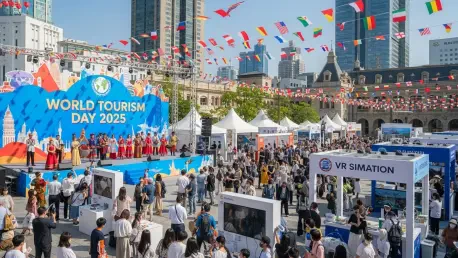Imagine a world where tourism does more than just fill hotels and boost economies—it heals communities, preserves ancient heritage, and protects the environment for generations to come. This vision took center stage in Melaka, Malaysia, during a landmark global event that drew over 700 delegates from around the world. Hosted by the Ministry of Tourism, Arts and Culture Malaysia (MOTAC) in partnership with United Nations Tourism and the Malacca State Government, this gathering from September 27 to 29 redefined the industry’s priorities. With the theme “Tourism & Sustainable Transformation,” Malaysia positioned itself as a trailblazer, challenging traditional approaches and advocating for a future where tourism serves as a force for good.
Setting the Stage: Malaysia Hosts World Tourism Day 2025
From September 27 to 29, Melaka, a historic city in Malaysia, became the epicenter of global tourism discourse by hosting World Tourism Day (WTD) and the World Tourism Conference (WTC). Organized by MOTAC alongside United Nations Tourism and the Malacca State Government, the event marked a pivotal moment for the industry. It brought together a diverse array of stakeholders, from policymakers to industry pioneers, all united by a shared goal of rethinking tourism’s role in the modern world.
The significance of this event cannot be overstated, as it attracted over 700 delegates, including key figures from the UN Tourism Secretariat, prominent industry leaders, and international media. Their presence underscored the global importance of the discussions held over these three days. The scale of participation highlighted Malaysia’s growing influence in shaping international tourism agendas.
Centered on the theme “Tourism & Sustainable Transformation,” the event aimed to establish a new benchmark for responsible and inclusive practices. Malaysia sought to demonstrate how tourism can drive positive change, not just economically but also socially and environmentally. This ambitious vision set the tone for a series of impactful dialogues and initiatives unveiled during the conference.
Defining Sustainable Tourism: Themes and Insights from WTC 2025
Shifting Priorities: Beyond Visitor Numbers
One of the core messages emerging from the conference was the urgent need to move beyond outdated metrics like tourist arrivals. Instead, the focus shifted toward evaluating tourism’s broader impacts—social, economic, and environmental. This reorientation reflects a growing recognition that sheer numbers do not equate to success in today’s complex global landscape.
Malaysia’s Minister of Tourism, Arts and Culture, Yang Berhormat Dato Sri Tiong King Sing, delivered a compelling address on this shift, highlighting pressing issues such as overtourism and unequal distribution of benefits. He emphasized that true transformation requires addressing these challenges head-on, advocating for policies that prioritize long-term sustainability over short-term gains. His call for actionable outcomes resonated with attendees, who agreed that symbolic gestures alone are insufficient.
The consensus at the conference was clear: sustainable tourism is now a cornerstone of global competitiveness. Delegates stressed the importance of protecting vulnerable destinations while ensuring local communities reap tangible rewards. This shared understanding marked a turning point, pushing for practical strategies that can be implemented across diverse regions.
Melaka as a Model: Heritage and Sustainability in Action
The choice of Melaka, a UNESCO World Heritage City, as the venue was both strategic and symbolic. It showcased Malaysia’s commitment to harmonizing tourism growth with the preservation of cultural and natural assets. Melaka’s historic charm provided a fitting backdrop for discussions on balancing economic ambitions with heritage conservation.
This city stands as a living example of how tourism can coexist with environmental care and cultural integrity. Its approach to managing visitor influx while safeguarding historical sites offers valuable lessons for other destinations. Delegates noted how Melaka’s model demonstrates the potential for heritage to drive economic progress without sacrificing identity or ecological balance.
Malaysia hopes that Melaka’s success will inspire other nations to adopt similar frameworks. By highlighting this city’s achievements, the conference illustrated that sustainable tourism is not a distant ideal but a feasible reality. The global audience left with a concrete case study of how history and modernity can work hand in hand for mutual benefit.
Challenges in Transforming Tourism: Obstacles to Sustainability
The journey toward sustainable tourism is fraught with obstacles, a reality that was candidly addressed during the event. Overtourism remains a significant concern, with popular destinations often overwhelmed by visitor numbers, leading to strain on infrastructure and resources. This issue poses a threat to both the visitor experience and the well-being of host communities.
Equally pressing is the challenge of ensuring equitable distribution of tourism’s benefits. Many regions struggle with disparities where profits are concentrated among a few, leaving local populations marginalized. Delegates discussed the need for mechanisms that empower communities, ensuring they have a stake in the industry’s growth rather than being sidelined by it.
Environmental degradation also looms large, with fragile ecosystems at risk from unchecked tourism activities. Protecting these areas while maintaining economic viability requires innovative solutions and robust policies. The conference emphasized collaborative efforts as essential to overcoming these hurdles, urging nations to share best practices and resources to address shared challenges.
Global Standards and Cooperation: Regulatory and Collaborative Frameworks
United Nations Tourism played a pivotal role at the event, outlining global guidelines for sustainable practices that nations can adapt to their unique contexts. These standards provide a roadmap for aligning tourism with broader goals of environmental stewardship and social equity. Their framework serves as a unifying force for an industry often fragmented by regional differences.
Malaysia demonstrated its commitment to these international benchmarks, positioning itself as a leader in implementation. By aligning national policies with global expectations, the country aims to set an example for others to follow. This dedication was evident in the initiatives and discussions that unfolded during the conference, showcasing a proactive stance on industry transformation.
The event also highlighted the value of global cooperation, symbolized by the handover to El Salvador as the next WTD host. Recognition of regional contributions, such as Laos’ involvement in events like the ASEAN Tourism Forum, further emphasized the importance of collective action. Such partnerships foster a sense of shared responsibility, encouraging nations to work together toward a common vision for the future of tourism.
The Future of Tourism: Malaysia’s Vision and Global Implications
Looking ahead, Malaysia unveiled ambitious plans with the launch of Visit Malaysia 2026 by Prime Minister YAB Dato’ Sri Anwar Ibrahim. This initiative focuses on building a “people’s economy,” where tourism prioritizes community well-being and cultural preservation over mere visitor volume. It signals a bold step toward redefining the industry’s purpose in the years to come.
Emerging trends such as resilience, inclusivity, and community-focused growth were also explored during the event. These concepts are gaining traction as critical components of sustainable tourism, addressing the need for systems that can withstand economic and environmental shocks. Malaysia’s emphasis on these areas positions it at the forefront of shaping the next era of global travel.
The potential for Malaysia’s approach to serve as a blueprint for other nations was a recurring theme. By demonstrating how to balance growth with sustainability, the country could influence international standards, particularly amidst pressing global challenges. This vision offers hope for an industry seeking direction in an increasingly interconnected and resource-constrained world.
Conclusion: Malaysia’s Blueprint for a Sustainable Tourism Legacy
Reflecting on the outcomes of World Tourism Day and the World Tourism Conference held in Melaka, it was evident that Malaysia took significant strides in championing sustainable and inclusive tourism. The event succeeded in shifting the narrative toward practical solutions, with Melaka serving as a powerful symbol of heritage-driven progress. The launch of Visit Malaysia 2026 further cemented the nation’s commitment to a transformative, people-centric approach.
Looking back, the discussions underscored the urgency of addressing overtourism, inequality, and environmental concerns through innovative strategies. As a next step, stakeholders must prioritize the development of adaptable frameworks that can be tailored to diverse destinations. Strengthening international partnerships will be key to scaling these efforts, ensuring that lessons learned in Malaysia ripple outward.
Beyond immediate actions, the industry must invest in long-term resilience by empowering local communities and integrating technology to monitor and mitigate impacts. Malaysia’s leadership during this event laid a foundation for change, but sustained collaboration across borders will determine the true legacy of these initiatives. The path forward demands a collective resolve to redefine tourism as a catalyst for global good.









